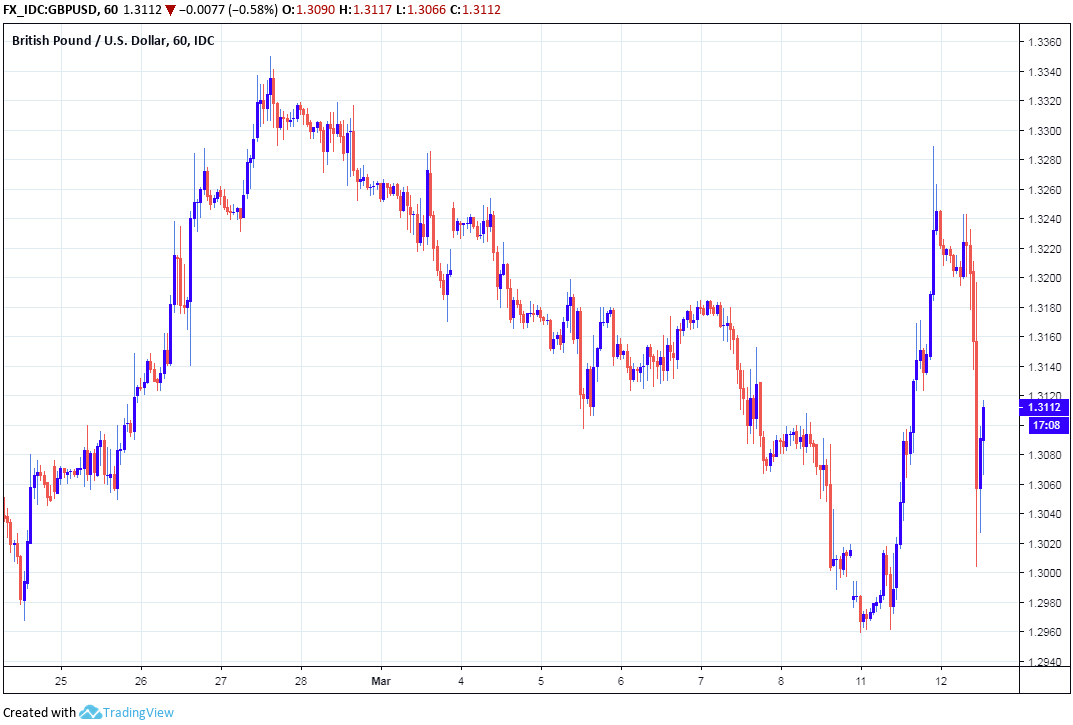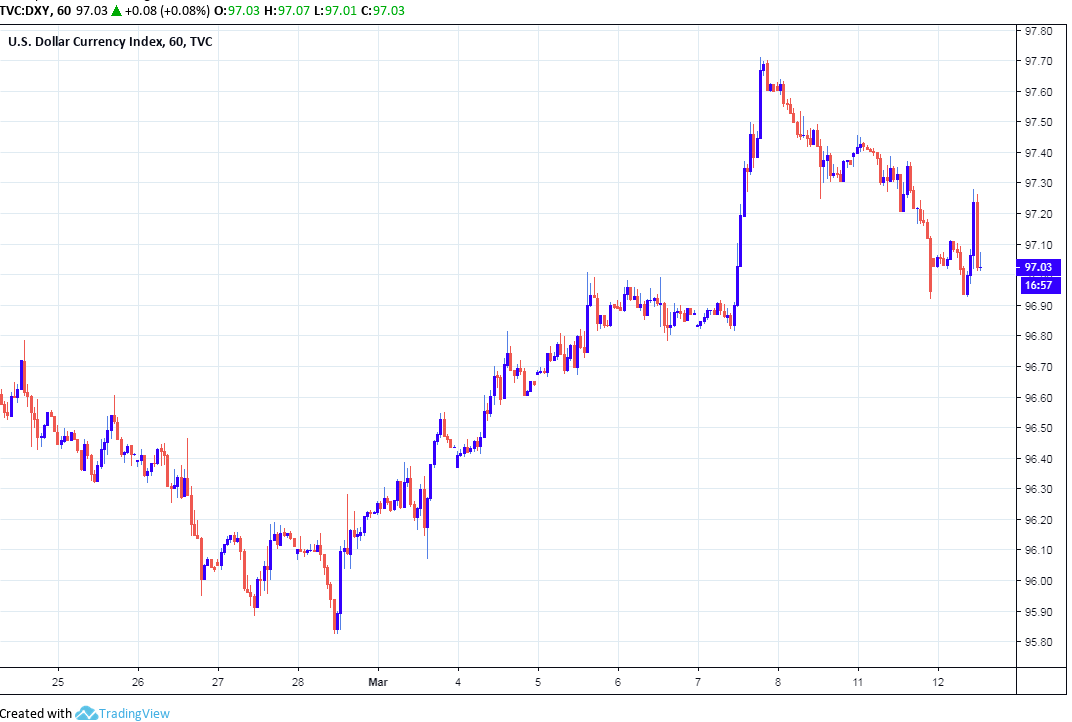U.S. Dollar Capitulates at Recent Highs after Inflation Disappointment Vindicates Fed for its Newfound Patience
- Written by: James Skinner
-

© Adobe Stock
- USD capitulates in risk off market after inflation surprises on downside.
- Feb decline in core CPI could vindicate Fed for newfound "patience".
- But a dire global outlook means USD to remain dominant for while yet.
The greenback capitulated close to range highs and slipped lower Tuesday after inflation surprised on the downside for the month of February, vindicating investors for having bet earlier this year that an end to the Federal Reserve (Fed) interest rate hiking cycle is nigh.
U.S. inflation rose by 0.2% in January, in line with economist forecats, although this still served to drag the annualised rate of price growth lower by 10 basis points to 1.5%. The outcome for the annualised rate is slightly better than the 1.4% economists had been looking for.
However, and on the downside, core inflation rose by just 0.1% in February when consensus had been for a gain of 0.2%. That pushed the annualised rate of core inflation down to 2.1% when markets had looked for it to remain unchanged at 2.2%.
A 0.7% fall in the price of used cars and zero percent change in the cost of medical care during February, following a period of consistent strong gains in the latter, were behind the decline in consumer price pressures during the recent month.
"Tame readings for recreation and medical care contributed to that outcome. Medical care gets an even larger weighting in core PCE prices, which should remain below the 2% Fed target. Slightly supportive for fixed income markets," says Avery Shenfeld, chief economist at CIBC Capital Markets.
Core inflation removes volatile energy and food items from the consumer goods basket and so is seen as providing a better reflection of domestically generated price pressures, which are what is important for questions around interest rates.
Markets care about inflation because it has implications for interest rates, which are themselves the predominant driver of exchange rates.
Interest rate decisions are only normally made in response to changes in the inflation outlook but impact currencies because of the influence they have over capital flows and short-term speculators.
"With headline CPI inflation edging down to a two-and-a-half-year low of 1.5% in February, from 1.6%, and core inflation dropping to a four-month low of 2.1%, from 2.2%, the Fed would appear to be justified in supporting the real economy by being patient and leaving interest rates on hold for a potentially extended period," says Paul Ashworth, chief U.S. economist at Capital Economics.
Ashworth and the Capital Economics team say the U.S. economy is currently enjoying its last day in the sun and that slowing growth, as well as falling inflation pressures, will force the Federal Reserve to begin cutting its interest rate some time in 2020. However, others have different views.
"We expect core inflation to remain steady at 2.1-to-2.2% over the next few months, but the message from the NFIB survey is that it will rise the second half of the year, likely breaching 2.5% by year-end. At that point, we think wage growth will be at or above 4%, posing awkward questions for the Fed if rates have remained at their current level," says Ian Shepherdson, chief U.S. economist at Pantheon Macroeconomics.

Above: Pound-to-Dollar rate shown at hourly intervals. Captures Tuesday's pre and post-CPI trading.
The Pound-to-Dollar rate was quoted -1.17% lower at 1.3080 following the release after paring back an earlier -1.45% loss, while the Euro-to-Dollar rate swapped an earlier -0.05% loss for a 0.18% gain when it traded up to 1.1279.
The Dollar index swiftly converted at 0.06% gain into a -0.16% intraday loss when it traded down to 97.03.
The greenback was higher against all G10 currencies other than the safe-haven Swiss Franc and Japanese Yen ahead of the release, but was down against everything other than the Pound and Swedish Krone following the report.
"USD has enjoyed a decent bid following the ECB-dovish pivot last week, but the global macro impulse has been sorely lacking, suggesting that regardless of the outcome US CPI will not do much to shake the dollar's stranglehold in the G10 at the moment," says Michael Hanson, head of macro strategy at TD Securities, in a note to clients ahead of Tuesday's release.

Above: U.S. Dollar index shown at hourly intervals.
Tuesday's capitulation and slide lower is notable because it comes in a risk-off market that had seen the Dollar buoyed by events in Westminster, London, where analysts are looking for clues as to whether MPs will be succesful later this week in preventing a so-called no deal Brexit from occuring on March 29.
"For a change the dollar is playing second fiddle to events in Europe, where Brexit dominates," said Chris Turner, head of FX strategy at ING Group, in a note to clients ahead of the inflation figures' release.
Tuesday's data comes a day after retail sales numbers showed the U.S. economy shifting into a lower gear early in the New Year, although the deceleration is in line with what has been observed elsewhere in the world.
The Fed said in January it will be slower to raise rates this year because it wants time to observe future developments in the global economy, given a slowdown overseas could easily undermine U.S. growth and inflation prospects.
That shift came amid a clear and protracted slowing of the Chinese and Eurozone economies, which is thought to have been brought about in large part by President Donald Trump's trade war with China.
Monday's retail figures followed a February nonfarm payrolls report that unsettled markets. The economy created just 20k new jobs last month, down from 311k in January, although unemployment fell from 4% to 3.8%.
In short, many recent U.S. economic figures have pointed toward a slowdown in growth over the coming quarters, at a time when the Federal Reserve is growing cautious about the outlook and more reluctant to raise its interest rate.
"It is not just the Fed and the ECB that are now perceived as having moved to a more dovish position. We have dropped our forecast for a BoE rate hike this year. The market read this month’s BoC statement as less hawkish than expected and there is speculation that the RBA could potentially cut rates twice this year. Meanwhile, the BoJ is showing no sign of steering away from its huge QQE programme," says Jane Foley, a strategist at Rabobank. "Against this backdrop it is likely that interest rate differentials will continue to support the USD in the coming months."
The above trend is important for the Dollar because it was an exceptional economic performance last year that enabled the Fed to lift its interest rate four times even as other central banks were sidelined by slowing growth.
This policy divergence powered the greenback to a near-5% gain last year but if the economy has now turned a corner the greenback could be looking at a much less exciting few quarters ahead of it. And until markets know which is more likely, Dollar exchange rates could remain trapped within their recent ranges.
"If a US-China trade deal results in the removal of the tariffs introduced last year, that would introduce an additional source of disinflationary pressure. In short, the Fed can safely ignore the minimal risk of a breakout in inflation above its 2% target," says Ashworth of Capital Economics.
Time to move your money? Get 3-5% more currency than your bank would offer by using the services of foreign exchange specialists at RationalFX. A specialist broker can deliver you an exchange rate closer to the real market rate, thereby saving you substantial quantities of currency. Find out more here.
* Advertisement









